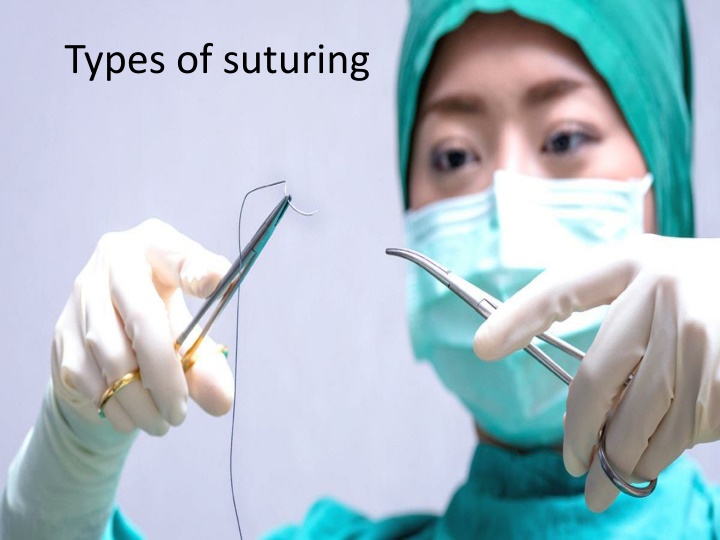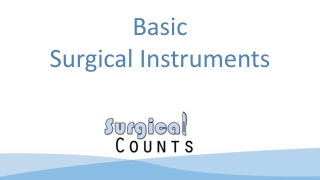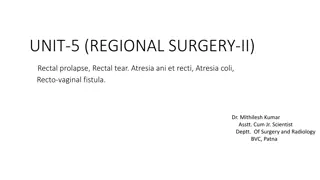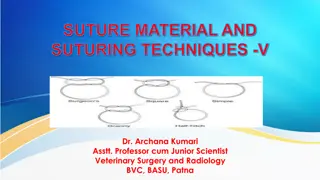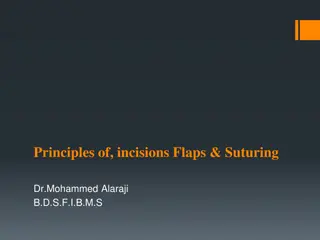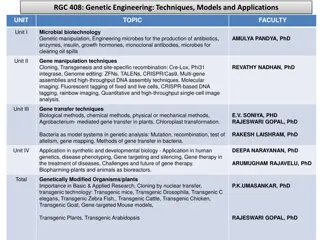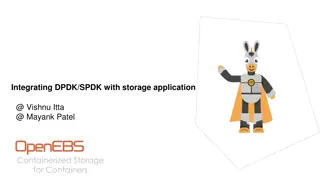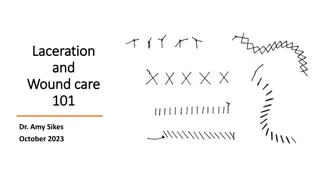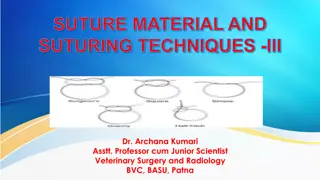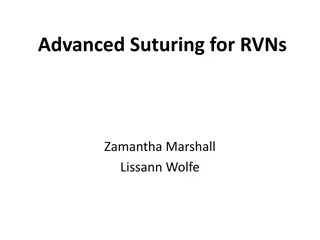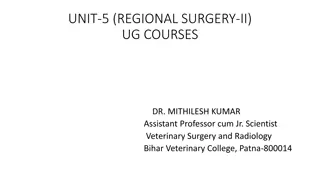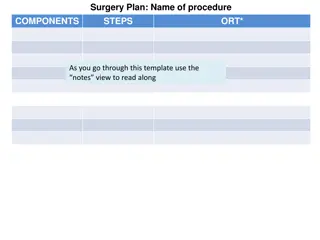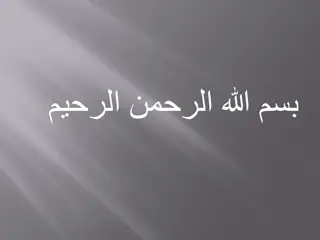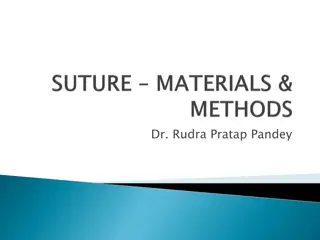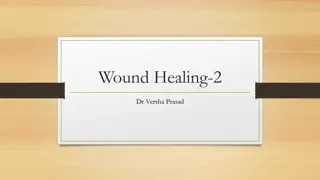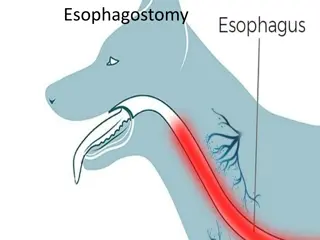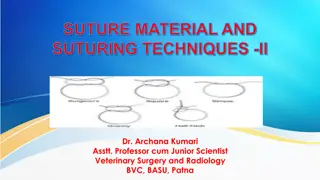Types of Suturing Techniques and Applications
Explore various types of suturing techniques such as simple interrupted suture, simple continuous suture, subcuticular suture, and Reverdin's continuous sutures. Each technique has its advantages and disadvantages, suited for different applications ranging from skin suturing to suturing blood vessels and nerves. Visual aids accompany detailed descriptions of each suturing method, highlighting their specific uses and potential outcomes.
Download Presentation

Please find below an Image/Link to download the presentation.
The content on the website is provided AS IS for your information and personal use only. It may not be sold, licensed, or shared on other websites without obtaining consent from the author.If you encounter any issues during the download, it is possible that the publisher has removed the file from their server.
You are allowed to download the files provided on this website for personal or commercial use, subject to the condition that they are used lawfully. All files are the property of their respective owners.
The content on the website is provided AS IS for your information and personal use only. It may not be sold, licensed, or shared on other websites without obtaining consent from the author.
E N D
Presentation Transcript
Simple interrupted suture Advantages: In this suturing, any stitch failed for any reason that did not affect the rest of the other stitches and is easy to use Disadvantages: It takes longer time to complete suturing It consumes more threads Increased tension may lead to inversion of the edges to inside Use: Suture of the skin, subcutaneous tissue, fascia, blood vessels, nerves and gut
Simple interrupted suture : : : ) ( fascia
Simple continuous suture technique Its advantages It take less time and less suture materials Preventing air and water leaks Good for layering stitches under a little tension Its disadvantages The failure of one of the stitches leads to the failure of the other stitches Increased tension during suturing causes puckering and strangulation of the skin Use Suture the skin, subcutaneous tissue, fascia, blood vessels and gut
simple continuous suture technique ( ) ( ) Strangulation Puckering
subcuticular suture technique 1. intradermal )interrupted subcuticular suture) It is upside down stitches so that the knots are inside and stitches are buried under the epidermis. continuous subcuticular suture It begins with upside down stitch and continues to suture as modifies horizontal mattress (such as the snake movement) Its advantages Less time and material It is used in some operations such as castration in dogs
Reverdin`s continuous sutures (interlocking suture) (lock stitch suture) (Blanket suture( It is a modulation of simple continuous suturing (a loop is made above the needle s exit point which when it exits through the loop it will be a self-locking stitch) It is used in the skin and diaphragm Its advantages When the knot fails or any part of the thread is defective, it may not lead to failure of all stitches Its disadvantages Use more threads and take more time When used on the skin and when placed under tension often buried in the skin as a result of pressure necrosis
Reverdin`s (interlocking suture) (lock stitch suture) continuous sutures (Blanket Suture) ) ) ( (
Vertical mattress suture The stitch consists of two parts, one is far from the edges of the wound, and the second is close to the edges. The first part of the stitch is 1-1.5 cm from the edge of the wound. As for the second part of the stitch, it must be as close to the edge as possible. It is useful in closing deep wounds, Facilitates blood circulation and reduce necrosis
Horizontal mattress suture The suture is placed parallel to the wound, so each stitch replaces two stitches It is either interrupted or continuous Rubber tube pieces or buttons can be used with horizontal mattress (interrupted) in the event of severe tension to prevent tissue rupture
Button suture This suturing is useful for supporting another type of suturing in the presence of a strong tension that may lead to cut the tissue during suturing (therefore it is considered a tension suture( it is vertical or horizontal mattress sutures , and buttons of appropriate size are placed
Quilled suture This suture is useful for supporting the edges of the wound, which exposed to a tension that cannot be overcome by the normal suture. It is a vertical mattress placed away from the edges and supported by two bars of appropriate size that enter the two loops before making the knotes. It is considered a tension suture Tension suture are placed for equal distribution of tension and to prevent cutting of skin which is under tension to avoid tissue damage.
Figure of 8(eight) suture Most commocly used for extraction socket closure after teeth extraction Advantage: Rapid closure Disadvantage: Due to its orientation, it is difficult to remove & it leaves a significant amount of suture threads inside the socket
Far near near far It is considered tension suture. It is a modification of interrupted vertical mattress The stitches start far from the edges of the wound, exit from the second side of the wound near the edge, and the needle enters the first side of the wound near the edge, then exits away on the second side. All stitches are placed before making the knot. You can use two piece of gauze to help protect and bandage the wound, and not need wrap on it, and its advantage a good opposite edges. This suturing is used where the bandage cannot be placed, such as the udder Note: tension suture: is the suture that closes the edges of the wound as little as possible to the tension of the tissue, so the possibility of cutting the tissue with the suture is less.
Purse string suture It is a single stitch placed around a circular opening to close the edges of the inside It is often used in the case of prolapse of the rectum, to prevent it from leaving temporarily, until the causes are removed
chmieden's intestinal suture It is continuous and used to suture the intestine It begins with a triple stitch and after that it always penetrates the intestinal wall from inside to outside, penetrating all layers, which leads to cross- edges without affecting the diameter of the intestine, and is then buried in a second row of suture type Lambert or cushing the purpose of the first row of surturing (Schmiden or Connell) is To close the edges of the wound The second row of suturing (lambert or cushing) is to turn the edges inside.
Connell suture It is used to suture internal organs (stomach or intestine) as a first row and penetrates all layers with stitches parallel to the wound and is usually followed by a second row of type lembert or cushing suture technique Connell suture is similar to cushing suture, but in cushing, the suture thread only penetrates the serous and muscular layer of the intestine and does not penetrate all of the layers.
Cushing suture It is used in suturing the intestine and other internal hollow viscera of the digestive system as a second row. Usually the first row is the Schmiden type when used in the intestine. It turns the edge of the surgical wound to inside and does not penetrate the mucosa and sub mucosa The suture stitches are parallel to the wound.
Lembert suture It usually used in digestive surgery It is used as a second row. it does not penetrate all layers but only penetrates serosa and muscularis layers It turns the edges to inside more than the rest of the suture types.
Halsted suture it is used to suture a fragile tissues such as the spleen and liver. It can also be used as a second row forsuturing the hollow viscera. It is a modulation to lambert suture, it penetrates only two layers when used to suture hollow viscera , where it leads to invert of the edges to inside.
